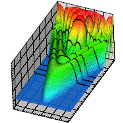Department of Physics and Astronomy: Publications and Other Research

Anthony F. Starace Publications
Document Type
Article
Date of this Version
November 1999
Abstract
The dependence on laser intensity of recently discovered plateau structures in laser-assisted x-ray–atom scattering, both with and without a static electric field present, is analyzed. Using the “three-step” model and the strong-field approximation we demonstrate a connection between laser-assisted, x-ray–atom scattering and high-order harmonic generation: For high laser-field intensities without a static field present, both processes have plateaus whose energies extend to the cutoff value 3.17Up, where Up is the ponderomotive potential energy. For x-ray–atom scattering in the presence of a static electric field we show that at high laser-field intensities two plateaus appear: One is our recently predicted high-energy plateau for the same process [Phys. Rev. Lett. 81, 5097 (1998)], while the other, low-energy plateau, has a differential cross section six orders of magnitude larger. The energy positions and relative magnitudes of these new plateaus are explained using semiclassical arguments.


Comments
Published by American Physical Society. Phys. Rev. A A 60, 3943 (1999). http://pra.aps.org. Copyright © 1999 American Physical Society. Permission to use.